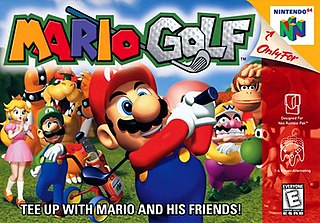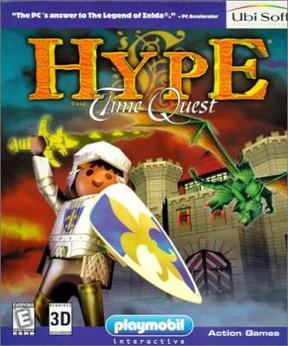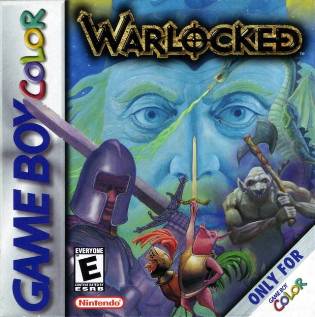
Mario Tennis is a 2000 sports video game developed by Camelot Software Planning and published by Nintendo for the Nintendo 64. Following Mario's Tennis, it is the second game in the Mario Tennis series. The game is known for being the introduction of Luigi's arch-rival, Waluigi, and the re-introduction of Princess Daisy and Birdo.
Heroes of Might and Magic, known as Might & Magic Heroes since 2011, is a series of video games originally created and developed by Jon Van Caneghem through New World Computing.

Heroes of Might and Magic III: The Restoration of Erathia is a turn-based strategy game developed by Jon Van Caneghem through New World Computing originally released for Microsoft Windows by The 3DO Company in 1999. Its ports to several computer and console systems followed in 1999–2000. It is the third installment of the Heroes of Might and Magic series.

Heroes of Might and Magic IV is a turn-based strategy game developed by Gus Smedstad through New World Computing and published by the 3DO Company for Microsoft Windows-based personal computers in 2002. A Macintosh port was subsequently developed by Contraband Entertainment and released by the 3DO Company. The fourth installment of the popular Heroes of Might and Magic franchise, it is the sequel to Heroes of Might and Magic III, and was the last to be developed by New World Computing.

Heroes of Might and Magic III: Armageddon's Blade is the first of two expansion packs for the turn-based strategy game Heroes of Might and Magic III. It was developed by New World Computing for Microsoft Windows and released by The 3DO Company in 1999.

Heroes of Might and Magic II: The Succession Wars is a turn-based strategy video game developed by Jon Van Caneghem through New World Computing and published in 1996 by the 3DO Company. The game is the second instalment of the Heroes of Might and Magic series and is typically credited as the breakout game for the series. Heroes II was voted the sixth-best PC game of all time by PC Gamer in May 1997.

New World Computing, Inc. was an American video game developer and publisher founded in 1984 by Jon Van Caneghem, his wife, Michaela Van Caneghem, and Mark Caldwell. It was best known for its work on the Might and Magic role-playing video game series and its spin-offs, especially Heroes of Might and Magic. The company was purchased by and became a division of The 3DO Company on July 10, 1996 from NTN Communications, after NTN purchased New World Computing for $10 million in stock.

Heroes of Might and Magic: A Strategic Quest is a turn-based strategy game developed and published by New World Computing in 1995 for DOS. A spin-off of New World Computing's Might and Magic series of role-playing video games, the success of Heroes of Might and Magic led to a number of sequels.

Warriors of Might and Magic is an action role-playing game developed and released by The 3DO Company for the PlayStation and Game Boy Color in 2000, and for PlayStation 2 in 2001. The three versions, although they all follow a similar storyline, are unique, especially the GBC version which is presented in 2D instead of 3D and has an almost completely different story. Each version of the game centers around the protagonist Alleron, who is wrongfully accused of committing necromancy by the Grand Inquisitor, and is exiled as a result. He is forced to wear the Mask of the Accused as a punishment for his crimes, which acts as a magnet to monsters. It is difficult to determine when the events of Warriors of Might take place in the Might and Magic timeline. However, it's speculated that it takes place in between Heroes of Might and Magic III and Heroes of Might and Magic IV.

BattleTanx is a 1998 action game released for the Nintendo 64, produced by The 3DO Company. The game was followed by a 1999 sequel, titled BattleTanx: Global Assault.

Mario Golf is a 1999 sports game developed by Camelot Software Planning and published by Nintendo for the Nintendo 64. Mario, his friends, and his enemies play golf on a variety of Mario-themed courses. Following NES Open Tournament Golf, it is the second game in the Mario Golf series. Camelot also developed a Game Boy Color version, which adds role-playing elements.

Mickey's Speedway USA is a Disney racing game for the Nintendo 64 and Game Boy Color, developed by Rareware and published by Nintendo under license from Disney Interactive. It is styled after other kart racers such as Mario Kart 64 and Diddy Kong Racing, and features characters from the Mickey Mouse universe racing across the United States. It is Rare and Nintendo's second Disney-themed racing game following Mickey's Racing Adventure (1999).

Army Men: Sarge's Heroes 2 is a third-person shooter video game developed and published by The 3DO Company for Nintendo 64, Game Boy Color, PlayStation and PlayStation 2. The game is a direct sequel to Army Men: Sarge's Heroes. Unlike the previous game which was more dark in tone, this game has more of a lighthearted storyline.

Heroes Chronicles is a series of turn-based strategy video games developed by Jon Van Caneghem through New World Computing and published by the 3DO Company. The series was intended to introduce a new audience, such as casual gamers, to the Heroes of Might and Magic series. As part of that strategy, each installment of Chronicles was released as a low-cost episode containing a relatively short single-player campaign, and the difficulty level of each game was kept low. All Chronicles games are based on a limited version of the Heroes of Might and Magic III game engine, although the ability to play scenario maps and multiplayer games is not included in any Chronicles title.

Army Men is a real-time tactics video game developed and published by The 3DO Company for Microsoft Windows and Game Boy Color.

Hype: The Time Quest is an adventure video game developed by Ubi Soft Montreal and published by Ubi Soft and was released under the Playmobil Interactive series of products. The game, released in the year 1999 along with Alex Builds His Farm (1999), is based on the medieval castle toy series from Playmobil. The U.S. version of the Game Boy Color version was supposed to be released in June 2000, but was delayed for over a year. The game revolves around Hype, a 22-year-old knight in the service of King Taskan IV, following a quest through time to return to his own time in order to save the kingdom from the evil black knight Barnak. Hype's adventures therefore take place in the same kingdom throughout four different periods of its history. The game was directed by Alain Tascan and featured thirty-two different voice actors, as well as original music by Robbi Finkel.

Warlocked is a real-time strategy video game developed by Bits Studios and published by Nintendo for the Game Boy Color. It was solely released in North America on July 24, 2000. Choosing between human and beast factions, the player plays through twelve scenarios from each faction, gathering resources, building fortresses, and managing troops to defeat the opposing force.

Army Men: Air Attack is a third-person shooter video game developed and published by The 3DO Company for PlayStation, Nintendo 64, Game Boy Color and Microsoft Windows. The game focuses on aerial combat and features the same protagonist, Cpt. William Blade. It is one of the first Army Men games to be powered by a 3D engine where terrain and units are rendered in real-time.

Heroes of Might and Magic III: The Shadow of Death is the second of two expansion packs for the turn-based strategy game Heroes of Might and Magic III. It was developed by New World Computing for Microsoft Windows and released by The 3DO Company in 2000. Shadow of Death is a standalone expansion pack that includes the original game.

















